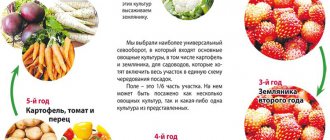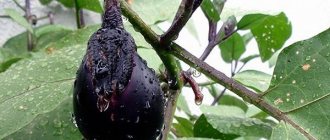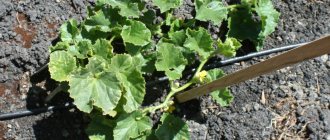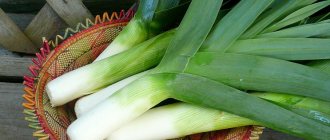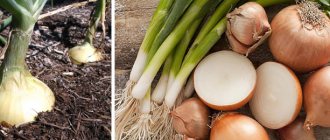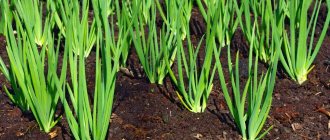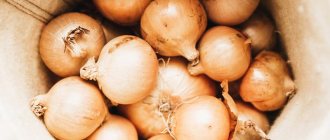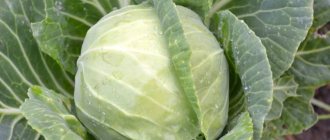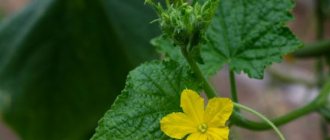Vegetable growing » Garlic
0
1200
Article rating
Kira Stoletova
Spices have long occupied an important place in the human diet, so they are planted by both large agricultural companies and summer residents. Proper cultivation of garlic will eliminate the slightest error at any stage of development. What proven plant cultivation technologies exist? Let's look at popular methods.
Rules for growing garlic
Description of culture
Garlic has a pungent odor and burning taste due to the content of allicin, an organic compound that works as an antimicrobial, antiparasitic and antifungal agent. The cloves of the collapsible head of garlic are used for eating raw and as an ingredient in a huge number of cooking recipes from all over the world. Especially a lot of garlic, up to 8–12 cloves per day, is consumed in China, Korea and Italy. According to statistics, China has recently produced more than 12 million tons of garlic per year, while Russia produces less than 300 thousand tons, and the USA produces more than 200 thousand tons.
A clove of garlic contains almost all food minerals and vitamins known to modern science. The main ones:
- iron; 100 g of garlic contains 1.7 mg of iron;
- thiamine; there is more of it in garlic than in any other vegetables;
- polysaccharides with great nutritional value;
- ascorbic acid is a powerful antioxidant;
- iodine, which is especially valuable for non-coastal areas with a lack of iodine in the diet;
- calcium, beneficial for the cardiovascular and skeletal systems.
It is the complete set of all microelements that a person needs that makes garlic literally an indispensable element of nutrition.
More than 70 varieties of winter and 14 spring garlic are cultivated in Russia - this is the number of varieties included in the State Register of Breeding Achievements. Perhaps ancient varieties with long-forgotten names are also grown in folk gardens, because garlic seed - cloves and seeds, as a rule, are not bought anywhere, but passed on, propagated from year to year, from generation to generation, and the beginning of this process lost in the depths of centuries, as well as the names of varieties.
Planting and propagating garlic
Garlic is mainly propagated by cloves. Immediately after harvesting, in the Central region of Russia this is July 10–20, the heads are cut off and dried in the shade.
The exact cleaning time is determined by the following criteria:
- the scales on the head dry out and become brittle;
- Having dug up the head, you can see new roots - this is the beginning of a new garlic germination cycle and it’s time to harvest;
- the teeth in the head fall apart easily.
Then part of the harvest is selected for storage and consumption, and part is left for planting. Before planting, the heads are divided into cloves, selecting only healthy ones. One central clove, attached to the stem, is also discarded . It is easy to distinguish - it is always irregular in shape, usually flat and flattened. If you plant it, next year a not quite normal head will grow, divided in two or with separate underdeveloped teeth. But such teeth can be fully used for food.
Important! It is undesirable to use too small and, conversely, large teeth for planting, of which there are only 2-3 in the head. Normal planting clove is medium size.
The teeth are never peeled - this is protection. On the contrary, bare cloves cannot be planted. Healthy planting material is not processed. But if mold, rot, or ulcers are present on individual samples, they are thrown out, and all clean planting material is dipped into a solution of copper sulfate at a concentration of 40 g (one level tablespoon) per 10 liters of water and immediately removed. This is a treatment against fungal diseases and putrefactive bacteria. Tiny larvae of pests, such as thrips and onion flies, can hibernate in garlic cloves. In the spring, as the shoots grow, they will emerge and begin to devour the plant. In order to be guaranteed to get rid of pest larvae, the seed teeth are washed in a saline solution - 200 g of table salt per 10 liters of water.
Deadlines
When planting winter garlic, it is important to pay attention to weather conditions. Every autumn there can be completely different weather on the same day of the calendar.
If garlic is planted too early, before prolonged heat, it will produce roots and green shoots, which are then killed by frost. In this case, the clove itself will have time to take root well before winter, but will be depleted by the growth of unnecessary shoots. If garlic is planted too late, it will not have time to take root; in the spring it will lag behind in growth and may freeze out faster than the rooted one.
The timing of planting winter garlic depends on the weather conditions of the region.
But, despite the fact that the weather is unpredictable, there are certain planting dates. This is, as a rule, in central Russia the end of September - the first half of October. In warmer regions - early November.
The technology for growing garlic is basically the same in all regions, no matter in the Moscow region, Belarus or Siberia. But there are differences related to climatic conditions. First of all, these are different dates for planting and harvesting. Also in Siberia and other frosty regions, special attention is paid to a safe winter, covering areas in frosty conditions with snow or mulch. Although rooted teeth tolerate frosts down to -25 ° C. And in cold climates there are fewer pests that can survive harsh winters.
Garlic needs loose neutral soil. The plant tolerates partial shading, but then the seedlings need to be planted less frequently.
Soil preparation
The best predecessors for garlic are nightshade and pumpkin. Other precursors, especially onion ones, use the substances needed by garlic.
You can additionally feed the soil for plowing with wood ash at the rate of 0.5 liters per 1–2 square meters. m.
Before planting, the soil must be loosened with a plow, milling cutter, cultivator or shovel to a depth of about 20 cm.
Garlic is planted at intervals of about 20 cm between rows and 6–8 cm between cloves.
For small areas, make furrows with the angle of a hoe or a hand bipod, 8–10 cm deep, along a stretched cord. There is no consensus on the exact planting depth. Some believe that in such furrows the cloves should be firmly inserted even deeper, 3–5 cm from the bottom of the furrow. As a result, at a depth of 10–15 cm, garlic will take root better and will not freeze, which is especially important for the northern regions.
In a small garden bed, make a hole with a small shovel along a stretched rope.
But such a depth is fraught with the fact that the garlic can rot in a rainy, warm autumn or spring, without having time to break through to the light. Therefore, the optimal planting depth should be considered 7–10 cm from the surface.
The main dangers of wintering are rotting during a warm, damp winter and freezing during snowless, frosty weather. Nothing can be done about the first one; spring garlic will have to be planted in the spring. If there is no snow, covering with a layer of mulch will save you from severe frosts: wood shavings, sawdust, straw, hay, peat, manure, compost, pine needles, leaves or factory-made covering material. But all this will need to be removed in time with the first warm one, so as not to interfere with growth or damage the shoots.
The planted garlic is covered with a hoe, holding it with its teeth up, with a rake or a flat cutter. The main thing is not to dislodge the planted garlic cloves from their location. There is no need to compact the soil.
Variety update
Over the years, under equal conditions and care, garlic can reduce productivity and get sick more often. These are signs that the variety is degenerating and that undesirable changes and diseases have accumulated. Then the planting material is updated, obtaining absolutely pure samples of the first generation, called super-elite, which are highly valued in all cultures.
To do this, at the beginning of the appearance of the arrows, they are not all cut off, but some of the most powerful ones are left for seeds, so-called bulbs among the people. They ripen at the same time as garlic. They are collected at the same time. One cap can contain several dozen bulbs. Outwardly, they look like tiny teeth.
7–10 days until garlic is fully ripe
Further, the timing and technology for growing seed from bulbs is the same as for growing garlic per head, with one difference: they are planted not so deep, only 5–7 cm. In the row between bulbs, a distance of 5 cm is enough (a matchbox is the length of ). The distance between the rows is the same as when planting adult garlic, at least 20 cm. Although, to save space, you can plant with an interval of 5 cm between the rows, but then there will be difficulties with passage between the rows during weeding.
Most often, bulblets for planting material are planted next to mature garlic, allocating several additional rows on the plantation for this purpose. In the summer of the first year, a young head of the first generation grows out of them. It clearly shows the individual teeth, fused into a single whole, and there is no need to separate them. This same head is planted in the same fall along with the rest of the garlic and next year they get a full head. The teeth from it serve as valuable planting material for an updated variety, free from diseases and genetic changes.
Protection from diseases and pests
There are several most common diseases that affect garlic plantings:
- neck rot - gray spots of a depressed appearance appear on the neck of the bulb and spread to the entire fruit. Preventive measures - dig up the crop in dry weather and keep the bulbs for 2-3 days outdoors in sunny weather;
- peronosporosis (downy mildew) appears on the foliage in the form of pale green spots, gradually acquiring a grayish-purple tone. Prevention: good illumination of the area, ventilation of the beds. Therefore, plantings are regularly weeded and thinned out if necessary;
- rust is a fungal disease that attacks foliage. In order for garlic to grow healthy, it is important to follow the rules of crop rotation. During the period of active growth of green mass, it is recommended to spray the plantings with a solution of copper oxychloride (dilute liquid soap and a tablespoon of copper oxychloride in 10 liters of water). Repeated treatment is done after 7 days;
Black mold affects garlic bulbs when stored improperly. To prevent infection, the crop is ventilated and warmed in the sun.
Downy mildew or peronosporosis
The main damage to the crop is caused by the onion fly. The larvae infect the garlic heads and the plants die. To repel the pest, the soil in the beds is sprinkled with wood ash or tobacco dust.
Stem nematodes eat plant stems. The main method of control is compliance with the rules of crop rotation. Salt treatment of seed gives good results. The bulbs are soaked in the solution for 15-20 minutes (3 tablespoons of salt are diluted in 5 liters of water). Additionally, in the fall, liming of the soil is carried out (2 cups of powder are scattered per square meter of bed).
Care
Garlic is easy to care for. The first and main thing to do in the spring, as soon as the soil dries out, is weeding. The soil can be easily and quickly loosened with a hand cultivator with a cutting bracket, cutting off all the weeds at the same time. It is a little more difficult to remove weeds between plants in rows. This requires a narrow hoe or hand weeding.
The second weeding is carried out at the beginning of summer. Preferably 3-7 days after the rain, when the weed seeds germinate. On cultivated plantations, where there are few weed seeds in the ground, two weedings per season are usually enough, because winter garlic is harvested early. On weedy plantations, weeding is necessary more often.
Removing young shoots from bolting varieties can be considered a labor-intensive maintenance operation. As soon as shoots twisted into a ring with a white ovary seed cap at the end appear from the axil of garlic foliage, they must be completely removed immediately. With the exception of those left for seeds.
Recent Entries
Lilac perennials that are beautiful, compact and do not crowd out other plants Why when buying seedlings you should not take the sellers’ word for it and how to determine the age of the plant using 3 signs Tomato seedlings have turned purple or whitish: why the color has changed and how to save the plants
Important! If the shoots are not removed, they will draw a lot of nutrients and moisture from the entire plant, and the garlic will not be able to grow a full head.
Garlic shoots are broken off or cut off at the base with pruning shears.
Today, varieties of garlic have appeared that do not form arrows. As a rule, this is a separate group of varieties - spring garlic, which is planted in the spring. But old school breeders believe that garlic must have an arrow, otherwise it is an abnormal plant. It is difficult to argue with this conservative view, especially since there are no comparative indicators for the total content of nutrients in different varieties.
Fact! Shooting varieties are more productive, have a sharper taste and are better stored.
Garlic arrows themselves are a unique food product. Just like cloves, they replenish the deficiency of biologically active substances in the body, help get rid of parasites, slow down aging, and so on. There are many culinary recipes for their preparation, but in any case, it is simply impossible to eat a lot of this product, it is so full of useful substances and quickly gives a feeling of fullness. Cooked garlic arrows taste like mushrooms. But, in general, the taste is not for everyone.
Local Russian winter garlic always has a purple-burgundy hue. It acquires a purple color just after the cold period.
Frosty winters turn local garlic purple
White garlic - either spring or imported, southern.
After weeding, the second care concern is to ensure that the soil is always moist and does not dry out. With a lack of moisture, the garlic feather turns yellow, first at the ends, then completely in the lower tier. If this happens on the eve of harvest, it is considered normal. If it is already at the beginning of summer, then the garlic will not be able to fill a full head, and watering will be needed.
Sometimes the reason for pen tips drying out can be more than just drought. The same can happen if the feather is damaged by onion fly and other pests. Freezing of autumn seedlings that managed to sprout in the autumn warmth and were caught in the frost can also have an effect. But often partial yellowing of the feather does not prevent you from getting a good head of garlic.
Photo gallery: popular varieties of winter garlic
Garlic variety Sofievsky is suitable for long-term storage
Podmoskovny variety garlic has a pungent taste and pungent aroma.
Garlic of the Lyubasha variety tolerates drought well. Early ripening garlic of the Belorussky variety is resistant to wet rot
High-yielding garlic variety Alcor is frost-resistant
Top dressing
Garlic is responsive to potassium and phosphorus fertilizers. Nitrogen fertilizers, including organic matter (manure), can cause rapid growth of feathers with an underdeveloped head. Mineral fertilizers are applied:
- in the fall, before digging, adding complex fertilizers in an amount of about 40 g per 1 square meter. m;
- during the growing season, with watering, dissolving fertilizers in an amount of 15–20 g per 10 liters of water.
The benefits of garlic from such supplements do not decrease. Firstly, not all phosphorus and potassium are found in garlic cloves. Secondly, phosphorus and potassium in certain forms are not harmful, but beneficial to the body. But almost certainly such fertilizing will change the structure, density, and acid-base environment of the garlic crop, so it will be stored much worse.
Spring garlic
Spring garlic has smaller teeth; they are arranged in a spiral. Its requirements for soil, tine planting depth, and care methods are the same as for winter crops. But there are differences.
Distinctive features of spring garlic are small cloves and white peel.
It is planted in the very early spring, as soon as the soil thaws and dries. At the beginning of growth, it is able to develop the root system only at soil temperatures from +3 to +10 °C. When it becomes much warmer, it will not be able to begin development normally and form a head.
The planting depth is shallower than that of winter, only 3–4 cm.
Spring garlic is harvested 30–45 days later than winter garlic, in mid-late August . The signs of maturity of spring and winter garlic are the same.
Photo gallery: popular varieties of spring garlic
The Gulliver variety of garlic has a universal purpose and is stored for a long time. The late variety of garlic Sagittarius is resistant to diseases
The Elenovsky garlic variety produces a rich harvest. The Parus garlic variety does not form shoots. The Sochi 56 variety of garlic can be stored for up to 2 years without loss of quality.
Garlic storage
In large agricultural holdings, garlic for storage is treated with preparations that destroy all microflora that cause the development of mold, rot and fungal infections, and also stop the germination of the heads. The composition of such drugs is not advertised, and many different methods are used for home storage. Among them there are very labor-intensive, costly and low-productivity ones, for example, immersing heads in molten paraffin or wax to create a protective film.
But garlic is not worth it, although it is a valuable product. However, among the accumulated popular experience there are valuable tips:
- Well-dried heads are placed in a glass jar, sprinkled with flour to reduce moisture, and sealed with an airtight lid.
- When stored in damp rooms, canvas bags are soaked in saline solution and garlic is stored in them.
- In dry rooms, garlic is stored in nets or bags, sprinkled with completely dry sawdust or onion peels.
- In small quantities, garlic can be stored in the refrigerator, wrapped in cling film.
- With any method, garlic is stored in the dark.
- The roots of the head are burned on the fire of a gas stove, this sterilizes, dries and prevents germination.
A significant amount of garlic is stored in an apartment in two ways:
- cold method. At temperatures from 0 to +5, for example, on a loggia or balcony, with low humidity;
- warm method for winter varieties, at room temperature, but not in the hottest place, at 18–20 degrees.
After harvesting, garlic is trimmed differently depending on the storage method. Sometimes it is stored by weaving it into wreaths or sheaves.
With this storage method, the garlic is well ventilated and remains dry.
In this case, the tops are left about 30 cm long. For sale in markets, a stem 7–10 cm long is left. For normal storage, they are cut shorter, leaving 2–3 cm of the stem.
Harvesting and storage
The approximate harvest period is late July-early September. There are several signs that serve as a guide:
- new leaves do not grow;
- the old foliage turned yellow and died;
- the heads have formed and acquired a color corresponding to the variety.
If you delay harvesting, the plants will begin to grow, the bulbs will disintegrate and you will not be able to store them for a long time. They dig up the crop with a pitchfork, carefully shaking off the soil. To dry, garlic is placed in a ventilated room for 7-10 days.
Before storing, the roots and leaves of the bulbs are cut off. Leave necks 2-5 cm long. A popular option is to weave garlic into braids or wreaths, without cutting off the leaves and stems. To give the braid strength, twine is used as a base. The end of the braid is made into a loop to hang the garlic on hooks. A simple option is to pour garlic into nylon stockings or simply make bunches.
The productivity of winter varieties is higher, but the bulbs are stored worse. The teeth dry out or become rotten. Therefore, it is important to maintain temperature parameters of 2-4°C and humidity 60-80%.
Garlic in greenhouses
Sometimes garlic is planted in greenhouses. But this is done extremely rarely, solely to obtain a green feather in the early stages. It turns out that there is a small demand for it on the market, although very limited. But growing garlic per head in greenhouses is a strange activity. Firstly, why take up expensive meters of greenhouses for them if it grows well outside. Secondly, by weight, the yield of garlic yield per 1 sq. m. is tens of times less than, for example, the harvest of cucumbers or tomatoes. Thirdly, garlic begins to germinate at +5–10 °C and grows normally at a temperature of +20–25 °C, and in summer in greenhouses on sunny days the temperature rises above +40 °C, when the garlic can simply burn.
When to plant
According to the technology for planting winter garlic, it is important to plant it in the soil in time. You can use the sowing lunar calendar, but it is more logical to focus on the climatic conditions of your region. The best option is considered to be the period from the beginning of September to October 10.
Follow the timing of planting winter crops according to technology
In warm regions, planting can be delayed until early November. There should be about a month to a month and a half left before the onset of stable frosts. This is important so that the roots of the cloves have time to take root. If you sow winter garlic ahead of time without following the planting technology, the cloves will sprout. However, if the winter vegetable managed to sprout in the fall, do not be alarmed. Garlic that has managed to take root and sprouted by winter will also bear fruit. To do this, the bed must be well mulched - with corn stalks, branches, sawdust, leaves.
Reviews from gardeners
Planting and harvesting times may vary. It all depends on the climate. In our country (Central Ukraine), we plant one-toothed ones on Pokrov, October 14, and remove them on Peter and Paul, July 12.
buevski
https://fermer.ru/forum/otkrytyi-grunt/80889
If a person plants garlic for 8 hours in a row, then the next day he will not get out of bed. I have never paid attention to productivity, since I don’t use hired labor; for me the main quality is important. In addition, the weather makes its own adjustments; garlic is planted in the fall. But. for example, last year four of us made 10 acres in a day and a half, 3–4 hours a day.
Vladimir G
https://fermer.ru/forum/otkrytyi-grunt/80889?page=1
In Soviet times, our family’s record: on 20 acres (0.2 hectares) we planted 750 kg of selected cloves and took 3 tons. In terms of hectares it comes out to 15 tons per hectare. But then it was difficult with fertilizer. It wasn't in the store. They planted very often, there was only 10 cm between the rows, 5-6 cm between the cloves. Planting by hand. weeding 4 times. Watering all summer 40–60 l/m2. The arrows were broken off in bags and thrown away.
Ashot
https://fermer.ru/forum/otkrytyi-grunt/80889?page=2
Preparing the beds
The best place for growing is a well-lit area with light, fertile, neutral or slightly acidic soil. Garlic is planted next to strawberries, tomatoes, spinach, carrots or cabbage. Preparation of the beds begins 14 days before the expected planting date of the cloves. Digging is carried out to a depth of 20 cm, weeds are removed and the soil is lightly compacted. The soil is also enriched with fertilizers. Use humus (5 kg/1m²), a specialized complex fertilizer for onions (20-30 g).
Video: autumn planting of garlic
If a family consumes garlic in average quantities, then, as a rule, the harvest from a small plot of 7–10 square meters is enough for food and for next year’s seed. m. A head of garlic may grow small and uncompetitive for sale in the market, but for your kitchen this does not matter. In addition, the cloves are large and in a small head, but there are fewer of them. The most painstaking work when growing garlic is autumn planting by hand, and spring-summer care, as we see, is quite simple. Especially in a small area. So having your own garlic is a good thing.
- Author: Gennady Chernikov
Rate this article:
- 5
- 4
- 3
- 2
- 1
(0 votes, average: 0 out of 5)
Share with your friends!
Features of winter varieties
Without understanding which garlic is winter and which is spring, you can waste time and effort growing it. The head of any winter variety has an arrow in the middle, on the top of which bulbs - small seeds - gradually ripen. Winter bulbs are usually larger than spring bulbs, in which the cloves often grow in two rows, as if superimposed on one another. The only disadvantage of this vegetable crop is its poor shelf life - you should try to use this product before the beginning of next year. Therefore, fresh winter slices are often spent on canning and pickles.
Selection of seed
It is necessary to take care in advance about the seed or planting material, which are aerial bulbs and heads. Already during the garlic growing period, note the most developed plants.
Experienced vegetable growers believe that they should choose specimens that form 10 leaves and are the first to emerge into the arrow. There is also another sign of plant selection - they have few leaves, but grow faster, form a harvest and are early in maturity.
When preparing bulbs for planting, it is necessary to discard specimens that have pinkish spots at the base - this is a sign of disease damage.
Business concept
Garlic, unlike other similar vegetables, is attractive for small businesses in the following ways:
- has a stable demand in any market: there are many dishes of various national cuisines where garlic is an integral element;
- has a relatively high market price throughout the year with a seasonal increase (up to 100-300%) in winter;
- simple agricultural technology that is accessible to almost any non-specialist;
- no need for large areas. This allows you to save on renting a site or processing it, and eliminates the need to officially register an individual entrepreneur. An area of land of less than 1 hectare used for growing crops is, by law, a private plot of land (personal subsidiary plot). Such a farm does not need to be registered (as well as paying taxes);
- can be sold to any retail chain, including city supermarkets, shops, restaurants, as well as to companies involved in the production of food additives, sauces, and seasonings.
There are many advantages to starting a garlic growing business, but you shouldn’t forget about some of the features and risks associated with growing this crop.
Firstly, garlic is a rather capricious plant, despite the fact that it itself is a natural antiseptic. Therefore, a greenhouse with a maintained microclimate is more suitable for growing it than open ground.
Secondly, storing garlic also requires special conditions, since wet, poorly dried garlic spoils very quickly.
Thirdly, the quality of garlic greatly depends on the seed. There are two growing options. The first - with “teeth”, the second - with dry seeds. With the first option, you can select low-quality garlic cloves and plant good ones, which requires additional labor. In the second case, you will have to trust the seed manufacturer, who sells them in bags.
Fourthly, the soil requires reclamation after each planting, since garlic leaves many pests in the soil.
But in general, growing garlic is a profitable activity, and then we will talk about what you need to start your own business.


